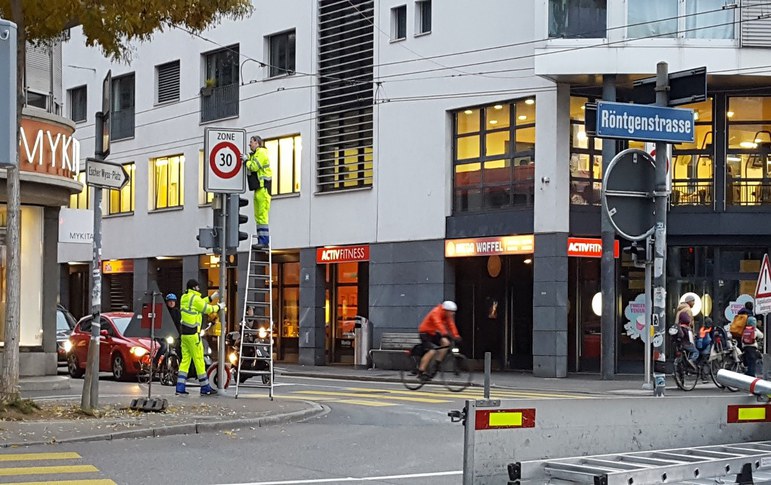
© Stadt Zürich (2022), ‘Tempo 30’ (https://www.stadt-zuerich.ch/pd/de/index/dav/themen_projekte/tempo_30.html), accessed 8 August 2022.
Context
In the city of Zurich, exposure limits for road traffic noise are exceeded on a network of about 230km. To reduce noise levels and improve the health and quality of life of the city’s residents, as required by the Environmental Protection Law and Noise Abatement Ordinance, the city of Zurich reduced the speed limit from 50km/h to 30km/h on parts of its street network.
The 30km/h speed limits are being implemented in three steps and the road length covered by the measure is expanded with each step. After the implementation of the final step, it is expected that, of the 140,000 residents, 28% will be protected from harmful noise levels during the day, while 17% will be protected at night.
The timescale for planning, implementing and evaluating the whole project covers the period from 2008 to 2030, barring unexpected court proceedings.
Measures and outcomes
Measurements in Zurich and other areas have shown that, when speed limits are reduced from 50km/h to 30km/h, an average noise abatement of between 3dB and 5dB can be achieved. To date, 30km/h speed limits have been implemented on 40km of road, benefiting 20,000 residents. By 2030, an additional 120km will be added, as well as a further 30km of night-time-only speed-limit zones. It is expected that 48,000 residents will benefit from this measure during the day and 95,000 residents will benefit during the night.
The health benefits of this measure were evaluated using surveys before and after implementation. Overall, the decrease in annoyance and noise-related sleep disturbance due to road traffic noise as a result of the speed reduction was greater than what would have been expected when considering only the decrease in noise levels. This means that, in addition to the decrease in the average noise level, other factors related to the lower driving speed may reduce noise annoyance and sleep disturbance. Residents with bedrooms oriented towards the street benefited significantly from the introduction of the 30km/h speed limit. In contrast, for persons with apartments or bedrooms facing away from the street towards an inner courtyard, the introduction of the 30km/h speed limit did not result in a reduction in noise annoyance. In addition, a significant increase in perceived traffic safety along the respective street sections was reported.
Apart from the additional costs for public transport, the measure is low cost and effective. Surveys have shown that most urban residents are in favour of 30km/h zones, although acceptance is reportedly greater in the city than outside urban areas.
Location
Zurich, Switzerland.
Source
Road traffic.
Scale
20,000 residents have benefited from the measure in Zurich to date, and, by 2030, an additional 48,000 residents will benefit in the day and 95,000 residents at night.
Type of measure
Reduction in speed limits from 50km/h to 30km/h in parts of the street network.
Co-benefits
Increased perceived traffic safety. The measure enables the narrowing of streets and the areas gained can be used for tree avenues/green spaces or bicycle lanes which may help to mitigate the effects of increasing temperatures due to climate change. Reductions in road traffic noise allow a greater degree of freedom in the planning of dwellings.
Website
https://www.stadt-zuerich.ch/pd/de/index/dav/themen_projekte/tempo_30.html

Document Actions
Share with others